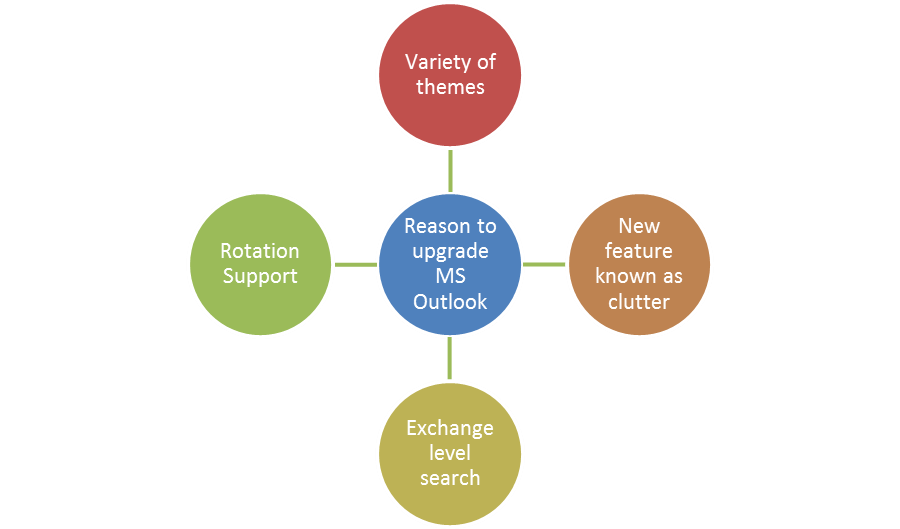
Manage contacts and make notes

Schedule your meetings

Manage different accounts on MS Outlook

Understand about Clutter which will help to manage inbox
As we know in this modern era Email has become one of the most frequently used methods of communication, whether it is used for personal, business or Professionally communications. It doesn’t matter whether you are working in a large or small organisation, email is the most preferred form of communication among the employees.
Nowadays many organisation has decided to implement corporate mail management system for, e.g., Outlook to communicate and organise meetings. It will also help to share your calendar and contacts with others.
Microsoft Outlook training is planned for delegates who have very less knowledge of the Microsoft Outlook 2016 users who want to learn the concepts covered in this course in the 2016 interface. Microsoft has added a new feature in the Outlook known as Clutter it moves emails that users ignored to Clutter to keep the Inbox clean.
Delegates will use Outlook to manage your email communications, including write, manage contact information; read, and respond to emails; schedule appointments and meetings; schedule tasks and create notes; customise message response options, and organise your mail. MS Outlook 2016 also provides different fonts for Arabic as well as Western European languages. This course will provide delegates with the knowledge and skills necessary to be a proficient user.

What is Microsoft Outlook Training?
Microsoft Outlook 2016 provides better organisation, social networking features, search capabilities, and communication. With this Microsoft Outlook 2016 training course, you will learn the four major components of Outlook including contacts, email, calendars and tasks that make things easy for users.
Why Should I take Microsoft Outlook Training?
This Outlook training is suitable for those delegates who want to upgrade their knowledge related to MS Outlook 2016, so they can compose and send, manage personal tasks, scheduling of meetings, and make notes.
Delegates will learn to customise a different set of command, manage different mail accounts, make rules to automate the variety of tasks, set different global options, attach files, check spelling. Apply filters to intercept mail and control spam, manage tasks, handle calendars and contacts, and archive data to protect it.
What are the benefits of Taking Microsoft Outlook Training?
Delegates will learn tasks such as:
Why choose Pentagon Training?
Pentagon Training is known as the best training Provider in all domains.Our instructors are certified and experienced so that delegates will not get difficulty during the course. Pentagon training is one of the most leading training providers of this training due to its high-quality content. It is most trusted by professionals and industry leading brands. Our well trained and experienced instructors teach that what is required by industry.
Enquire Now
----- OR -------
Reach us at +44 1344 961530 or info@pentagonit.co.uk for more information.
Sunderland
Sunderland also referred as Sunderland A.F.C, Tyne and Wear. It is located on River Wear in England. Sunderland comprises of the neighbouring towns like Washington and Houghton-le-Spring as well as city. Sunderland is referred as UK Parliament Constituency from 1832 to 1950. Sunderland A.F.C is a professional football team.
History
The population of Sunderland was 146,000 during 1901. First electric trams started in Sunderland in 1900. However in the 1940s and 195-s electric trams were replaced by buses. Last trams ran in Sunderland in 1954. Sunderland Technical College was opened in 1901. In 1904 Bede Memorial was raised and in 1907 Commissioners offices were built. In 1907 Empire Theatre was also opened. In 1909 Barnes Park was opened. Backhouse Park in 1923. Thompson Park in 1933. In 1902 Roker Breakwater was built and South Breakwater in 1914.
Boundaries of Borough were extended in 1928 to include Southwick and Fulwell. In 1929 New Wear Bridge has been constructed. A general hospital was opened in 1929. In 1934 was Deep Water Quay was opened. Council started slum clearance in Sunderland in 1930s. New council houses were built to replace the old slums located in Ford Hall, Marley Pots and Leechmere. During Second World War 267 people were killed due to German bombing. About 1000 houses were destroyed, and about 3000 got damaged. In 1967 boundaries of Sunderland were extended to include Silksworth, South Hylton, Herrington, Ryhope and Castletown. In 1969 Sunderland Polytechnic was founded and was made university in 1992. In 1970 civic centre and the new town hall was built. In 1973 new Police station has been constructed.
In 1973 Monkwearmouth Station Museum was opened. In 1974 North East Aircraft Museum was founded and new General Hospital was opened in Sunderland in 1978. Sunderland suffered in the 1930s when third of the men were unemployed. During 1950s Joblessness lowered and in 1980s unemployment returned. In late 20th century, Sunderland’s coal mining declined rapidly. After 1986 no more coal was exported. New industries replaced the old ones. Sunderland is well known for its car making industry. Other industries in Sunderland include electronic engineering, papermaking, mechanical engineering and textiles. Sunderland was made a city in the year 1992. In 1995 Sunderland Library and Arts Centre was opened. In 1997 Stadium of Light was opened and in 1998 National Glass Centre was opened. In 2002 Tyne and Wear Metro was expanded to Sunderland. In the beginning years of 21st century, Sunniside area was regenerated. Sunderland Aquatic Centre was opened in 2008. Now the population of Sunderland is 275,000.
We are offering more than 250 courses at 91 locations in UK.